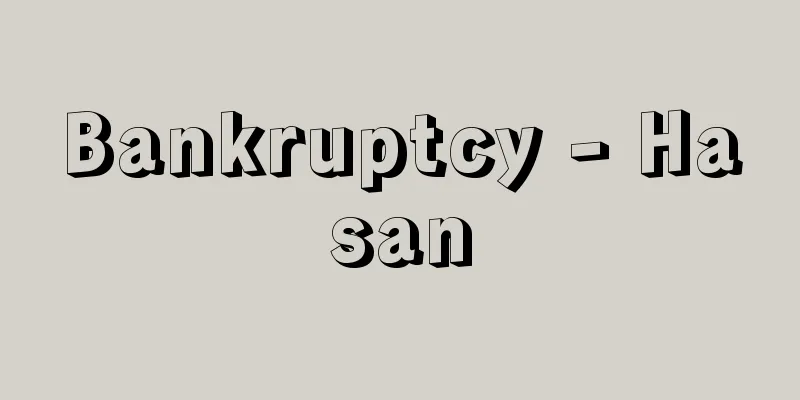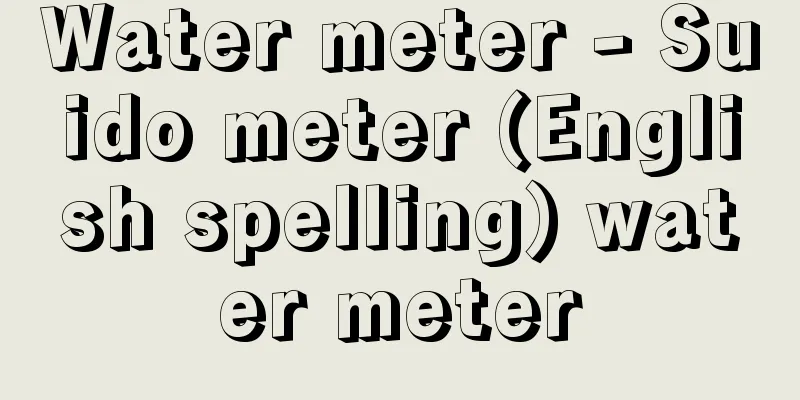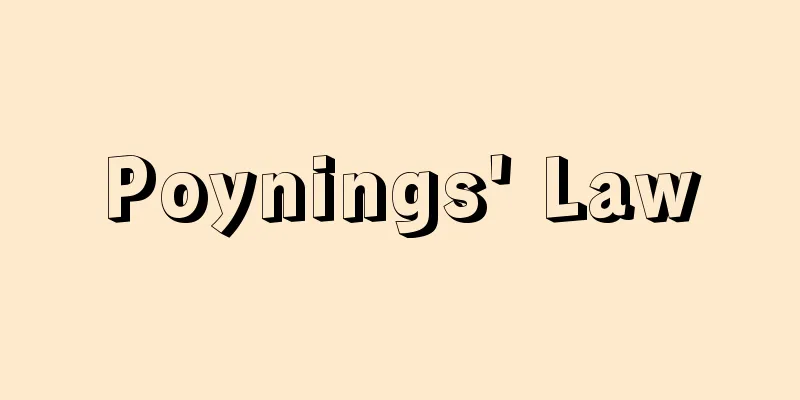Bankruptcy - Hasan

|
Bankruptcy is a legal procedure for a debtor who is financially bankrupt and is unable to repay all of his/her debts to all creditors with his/her ability to repay. The purpose of the bankruptcy is to force the bankruptcy trustee appointed by the court to manage and liquidate all of the debtor's assets, in order to provide fair financial satisfaction to all creditors. When there are many competing creditors and there are insufficient assets to repay their debts, a special method of protecting rights is required, and bankruptcy procedures respond to this need. In order to regulate such procedures, the Bankruptcy Act (Act No. 71 of 1922) was enacted, and this act was completely revised in 2004 (Act No. 75 of 2004). [Takeyoshi Uchida and Tetsuo Kato] Decision to commence bankruptcy proceedingsIn principle, bankruptcy proceedings are commenced when a creditor or debtor files a petition for the commencement of bankruptcy proceedings with the district court of the debtor's residence (Bankruptcy Law, Articles 4 to 7, Article 15 et seq.). The court must first require the prepayment of expenses (Bankruptcy Law, Article 22), and if necessary, take measures such as provisional measures (Bankruptcy Law, Article 24 et seq.), and then, in principle, conduct a hearing in accordance with the Code of Civil Procedure (Bankruptcy Law, Article 13). If the court finds that there is no cause for the commencement of bankruptcy proceedings, it will dismiss the petition, and if it finds that there is cause for the commencement of bankruptcy proceedings, it will make a decision to commence bankruptcy proceedings (see Bankruptcy Law, Articles 30 et seq.). At the same time as making the decision to commence bankruptcy proceedings, the court must appoint a bankruptcy trustee, determine the period for filing proofs of claims, the date of a creditors' meeting to report on the status of assets, the period for investigating claims, etc., and make public announcements of these matters, and must issue the required notices and request the registration of the commencement of bankruptcy proceedings (Bankruptcy Law, Articles 32, 257, and 258. Registration is described in Article 262). Procedures after the commencement of bankruptcy proceedingsThe debtor becomes bankrupt at the same time as the decision to commence bankruptcy proceedings is made, and loses the right to manage and dispose of assets belonging to the bankruptcy estate (Bankruptcy Law, Articles 34 and 78, Paragraph 1). In addition, the debtor is subject to various restrictions on his/her personal life, such as restrictions on leaving his/her place of residence (Bankruptcy Law, Article 37), enduring measures such as arrest (Bankruptcy Law, Article 38), and being obligated to provide explanations (Bankruptcy Law, Article 40) and to disclose important assets (Bankruptcy Law, Article 41). The bankrupt is free to dispose of assets acquired through his/her own business or labor after the commencement of bankruptcy proceedings (free assets), but the assets owned at the time of the commencement of bankruptcy proceedings constitute the bankruptcy estate, and the bankruptcy trustee will manage and dispose of the assets under the supervision of the court, and will also be in possession of and manage the assets (Bankruptcy Law, Articles 34, Paragraph 1, 75, 78, Paragraph 1, and 79). The bankruptcy trustee may terminate or demand performance of bilateral contracts that have not been performed by either the bankrupt or the other party at the time the bankruptcy proceedings are commenced (Article 53 of the Bankruptcy Law). The validity of legal acts performed by the bankrupt before and after the commencement of bankruptcy proceedings is determined by special provisions (Articles 47 to 51 of the Bankruptcy Law). Property claims against the bankrupt that arose from causes prior to the commencement of bankruptcy proceedings become bankruptcy claims (Articles 2, Paragraphs 5 and 6, Articles 97 et seq. of the Bankruptcy Law), and creditors must file their claims within a specified period, and the court clerk must prepare a schedule of bankruptcy creditors based on this (Article 115 of the Bankruptcy Law). An investigation must be conducted as to whether the filed bankruptcy claims exist. In principle, the investigation is conducted within the specified period of investigation into the bankruptcy claims, depending on whether the bankruptcy trustee accepts or rejects the existence and amount of the filed bankruptcy claims, and whether the filed bankruptcy creditor objects. If the bankruptcy trustee accepts the filed bankruptcy claim or there is no objection from the filed bankruptcy creditor, the bankruptcy claim will be determined as filed (Article 124, Paragraph 1 of the Bankruptcy Law). If the bankruptcy trustee does not accept the filed bankruptcy claim or there is an objection in writing from another filed bankruptcy creditor, the bankruptcy creditor who objected may file an application for appraisal against the bankruptcy trustee or the person who raised the objection (Article 125, Paragraph 1 of the Bankruptcy Law). In addition, if a bankruptcy claim that is disregarded by the bankruptcy trustee or objected to by another filed bankruptcy creditor is a notorious claim with an enforceable debt instrument or final judgment, the bankruptcy trustee or the objector may only raise an objection against that bankruptcy creditor through litigation procedures that the bankrupt can take (Article 129, Paragraph 1 of the Bankruptcy Act). Once the investigation of the claims is complete, the bankruptcy trustee will liquidate the assets of the bankruptcy estate (Article 184 of the Bankruptcy Law). In the process, if the bankrupt person has acted to reduce his/her assets before the commencement of bankruptcy proceedings, the trustee will exercise the right of avoidance to recover the assets (Articles 160 et seq. of the Bankruptcy Law), and if a third party exercises a right of segregation, the trustee will separate from the bankruptcy estate any assets that do not belong to the bankrupt person and return them to the person entitled to segregation (Articles 62 to 64 of the Bankruptcy Law). In addition, the trustee will pay estate claims from the bankruptcy estate as needed (Articles 2-7 and 151 of the Bankruptcy Law). Dividends and termination of bankruptcy proceedingsThe bankruptcy trustee may prepare a distribution table during the above procedures and distribute the bankruptcy estate to each creditor in proportion to their claims (Bankruptcy Law, Article 209 et seq.), and from the remaining distributed estate, the bankruptcy trustee's remuneration as determined by the court (Bankruptcy Law, Article 87) is deducted and the remaining amount is distributed to the creditors in proportion to their claims (Bankruptcy Law, Article 195 et seq.). If any assets are generated after the distribution, the bankruptcy trustee may distribute additional assets (Bankruptcy Law, Article 215). After the distribution is completed, the creditors' meeting for the purpose of the bankruptcy trustee's accounting report (Bankruptcy Law, Article 88, Paragraph 4) is completed, or the period for filing objections to the accounting report (Bankruptcy Law, Article 89, Paragraph 2) has elapsed, the court shall make a decision to close the bankruptcy proceedings and publicly announce the same (Bankruptcy Law, Article 220). This will end the bankruptcy proceedings. In addition to the above, bankruptcy proceedings may be terminated due to a shortage of the bankruptcy estate or the consent of all bankruptcy creditors (Bankruptcy Law, Articles 217 and 218). [Takeyoshi Uchida and Tetsuo Kato] Disclaimer and reinstatementBankruptcy proceedings are procedures aimed at liquidating assets that are insufficient to pay off all debts, and paying all bankruptcy creditors in proportion to the amount of their claims, so it is assumed that bankruptcy creditors will not receive full payment. If bankruptcy creditors were allowed to exercise their rights against assets acquired by the bankrupt after the bankruptcy proceedings began for the remaining amount of bankruptcy claims after the bankruptcy proceedings are concluded, there is a risk that the bankrupt will be unable to recover financially. Therefore, in 1952 (Showa 27), the system of bankruptcy discharge from the bankruptcy system of the common-law system was introduced into the old Bankruptcy Act (Articles 366-2 to 366-20 of the old Bankruptcy Act), and this system has been carried over to the current law (Articles 248 and following of the Bankruptcy Act). Under this system, unless the bankrupt person has engaged in certain dishonest behavior, the court will make a decision to grant a discharge upon the bankrupt person's petition (Article 252, Paragraph 1 of the Bankruptcy Law). Once the decision to grant a discharge becomes final, the bankrupt person is relieved of responsibility for the remaining debts to bankruptcy creditors (Article 253, Paragraph 1, Main Text of the Bankruptcy Law). However, from the perspective of the public interest, taxes, damages based on torts, salary claims based on employment relationships, etc. are not discharged (Article 253, Paragraph 1, proviso), and the effect of the bankruptcy discharge does not affect the debts of the bankrupt person's guarantors, etc. (Article 253, Paragraph 2 of the Bankruptcy Law). In addition, when a decision is made to commence bankruptcy proceedings, the bankrupt person is restricted from obtaining certain public qualifications. For example, there are provisions in Article 847, paragraph 3 and Article 852 of the Civil Code, Article 56, paragraph 1, paragraph 3 of the Trust Act, Article 14 of the Notary Public Act, Article 7, paragraph 5 of the Attorney Act, Article 4, paragraph 4 of the Certified Public Accountant Act, Article 8, paragraph 10 of the Patent Attorney Act, and Article 5, paragraph 3, paragraph 1 of the National Public Service Act. In the case of an equity company, its members will automatically leave the company upon bankruptcy (Article 607, paragraph 1, paragraph 5 of the Companies Act), and a person who has not yet passed a certain period of time since being convicted of a crime under the Bankruptcy Act cannot become a director of a joint-stock company (Article 331, paragraph 1, paragraph 3 of the Companies Act). In addition, a director loses his/her position when a decision is made to commence bankruptcy proceedings (Article 653, paragraph 2 of the Civil Code). However, restricting the public qualifications and other rights of a bankrupt person simply because of bankruptcy would be an obstacle to the bankrupt person's efforts to get back on his/her feet. Therefore, in 1952, the old Bankruptcy Act introduced a system of reinstatement along with bankruptcy discharge (Articles 366-21 to 373 of the old Bankruptcy Act), which has been carried over to the current law (Articles 255 and following). A bankrupt person's rights are automatically restored when the decision to grant a bankruptcy discharge becomes final (Article 255, Paragraph 1 of the same Act), and if he or she is relieved of liability for the entire amount of the bankruptcy claim by paying the full amount or other means, he or she can obtain a decision to reinstate the bankruptcy by filing a petition for reinstatement (Article 256, Paragraph 1 of the same Act). In addition, as a system for preventing bankruptcy before it reaches bankruptcy and facilitating the debtor's economic recovery, there are civil rehabilitation procedures under the Civil Rehabilitation Act (Act No. 225 of 1999) for both individuals and corporations, and reorganization procedures under the Corporate Reorganization Act (Act No. 154 of 2002) for joint-stock companies. [Takeyoshi Uchida and Tetsuo Kato] "Tetsuo Kato, Lecture Series on Legal Studies: Bankruptcy Law" (2009, Kobundo) [References] | | | | | | | | | | | |Source: Shogakukan Encyclopedia Nipponica About Encyclopedia Nipponica Information | Legend |
|
債務者が経済的に破綻(はたん)して、その弁済能力をもっては、総債権者に債務を完済することができなくなった状態に対する法的手段として、強制的にその者(破産者)の全財産を裁判所の選任する破産管財人が管理換価して、総債権者に公平な金銭的満足を与えることを目的とする裁判上の手続をいう。多数の債権者が競合する場合に弁済に充当すべき資産が不足するときは、特別の権利保護の方法が必要となるのであって、破産手続は、この要請に対応するものである。このような手続を規律するために、破産法(大正11年法律第71号)が制定されたが、同法は2004年(平成16)に全面的に改正された(平成16年法律第75号)。 [内田武吉・加藤哲夫] 破産手続開始の決定破産手続は、原則として債権者または債務者から、債務者の居住地などの地方裁判所に破産手続開始の申立てをしたとき(破産法4条~7条、15条以下)に開始される。裁判所は、まず費用を予納させ(同法22条)、必要に応じて保全処分など(同法24条以下)をしたうえで、原則として民事訴訟法にのっとって審理し(破産法13条)、破産手続開始の原因がないと認めるときは申立てを棄却し、破産手続開始の原因があると認めたときは破産手続開始の決定をする(同法30条以下参照)。破産手続開始の決定と同時に裁判所は破産管財人を選任し、債権届出(とどけいで)の期間、財産状況を報告するための債権者集会の期日、債権調査期間などを定めてこれらの事項を公告し、所定の通知および破産手続開始の登記を嘱託しなければならない(同法32条、257条、258条。なお、登録については同法262条)。 破産手続開始後の手続債務者は、破産手続開始の決定と同時に破産者となり、破産財団所属財産に関して管理処分の権能を失う(破産法34条、78条1項)ほか、居住地を離れることの制限(同法37条)、引致(同法38条)などの処置を忍受し、説明義務(同法40条)、重要財産開示義務(同法41条)を負うなど、身上に種々の拘束を受けることになる。破産者が破産手続開始後に自らの事業や労働などによって取得した財産の処分は自由である(自由財産)が、破産手続開始の当時所有していた財産は破産財団を構成し、破産管財人が裁判所の監督の下で管理処分を行うとともに、その占有管理にあたることとなる(同法34条1項、75条、78条1項、79条)。 破産管財人は、破産手続開始の当時破産者と相手方の双方がともに履行を終えていない双務契約を解除しまたは履行を求めることができる(同法53条)。その他破産手続開始前後にわたって破産者のなした法律行為の効力などについては特別の規定(同法47条~51条)によって定められている。破産手続開始前の原因に基づいて生じた破産者に対する財産上の請求権は破産債権となり(同法2条5項・6項、97条以下)、債権者は所定の期間内に債権を届け出て、裁判所書記官はこれに基づいて破産債権者表を作成することとなる(同法115条)。 届出のあった破産債権の存否などについて、調査が行われなければならない。調査は、原則として、所定の債権調査期間内に届出のあった債権の存否やその額などについての破産管財人の認否、届出破産債権者の異議の有無による。破産管財人が届出破産債権を認め、または届出破産債権者の異議がなければ、届出の通り破産債権は確定する(同法124条1項)。破産管財人が届出のあった破産債権を認めずまたは他の届出破産債権者から書面による異議のあったときは、異議が述べられた破産債権者は、破産管財人または異議を述べた者を相手として、査定申立てをすることができる(同法125条1項)。なお、破産管財人が認めずまたは他の届出破産債権者から異議を述べられた破産債権が、執行力ある債務名義または終局判決などを有する有名義債権であるときは、破産管財人または異議者は、その破産債権者を相手として破産者がすることのできる訴訟手続によってのみ異議を主張することができる(同法129条1項)。 債権の調査が終わると、破産管財人は破産財団の財産について換価を行う(同法184条)。その過程では、破産者が破産手続開始前に財産減少などの行為をしたときは、否認権を行使して財産の回復を図り(同法160条以下)、第三者から取戻権の行使があったときは、破産財団のなかから破産者に属さない財産を別離して取戻権者に財産等を返還する(同法62条~64条)。また、破産財団のなかから財団債権を随時に弁済する(同法2条7項、151条)。 配当、破産手続の終了破産管財人は以上の手続の途中でも配当表を作成して、適宜その破産財団を各債権者の債権額の割合に応じて中間配当することができ(破産法209条以下)、最後に残った配当財団のなかから、裁判所の定める破産管財人の報酬(同法87条)を差し引いた残額を債権額の割合に応じて債権者に最後配当をし(同法195条以下)、またその後に配当にあてるべき財産を生じたときは追加配当をする(同法215条)。配当が終わると、破産管財人の計算報告を目的とする債権者集会(同法88条4項)終了後、または計算報告についての異議申立ての期間(同法89条2項)が経過したときは、裁判所は破産手続終結の決定をして、その旨を公告する(同法220条)。これにより破産手続は終了する。破産手続が終了する場合には、以上のほか破産財団の不足、総破産債権者の同意などによる破産手続の廃止(同法217条、218条)がある。 [内田武吉・加藤哲夫] 免責・復権破産手続は、全債務の完済のためには足りない資産を換価して、総破産債権者に対しその債権額の割合に応じて弁済することを目的とした手続であるので、破産債権者は全額の弁済が受けられないことを前提としている。破産手続が終結した後に破産債権の残額について、破産者の破産手続開始後に取得した財産に対して破産債権者の権利行使を認めると、破産者の経済的再起は不可能になるおそれがある。そこで、1952年(昭和27)に英米法体系の破産制度にある破産免責の制度が旧破産法に導入され(旧破産法366条ノ2~366条ノ20)、それは現行法に引き継がれている(破産法248条以下)。 この制度では、破産者に一定の不誠実な行動のない限り、破産者の申立てにより裁判所は免責許可の決定をする(同法252条1項)。免責許可の決定が確定すると、破産者は破産債権者に対する残額債務についての責任を免れる(同法253条1項本文)。しかし公益的見地から、租税、不法行為に基づく損害賠償義務、雇用関係に基づく給料債権などは免責されないし(同法253条1項但書)、破産免責の効力は破産者の保証人などの債務についても影響を及ぼさない(同法253条2項)。 また、破産手続開始の決定があると破産者は一定の公的資格につくことを制限される。それらに関しては、たとえば民法第847条3号・第852条、信託法第56条1項3号、公証人法第14条、弁護士法第7条5号、公認会計士法第4条4号、弁理士法第8条10号、国家公務員法第5条3項1号などの規定がある。持分会社については、その社員は破産によって当然に退社となるし(会社法607条1項5号)、破産法上の犯罪を犯し有罪判決を受けた後一定の期間を経過していない者は株式会社の取締役となることができない(会社法331条1項3号)。また、取締役が破産手続開始の決定を受けたときはその地位を喪失する(民法653条2号)。しかし、破産という一事だけで破産者に対する公的資格その他を制約することは、破産者が再起を図るうえで障害となろう。そこで、1952年に、旧破産法において破産免責とともに、復権の制度が導入された(旧破産法366条ノ21~373条)、それは現行法にも引き継がれている(破産法255条以下)。破産免責許可の決定の確定などにより破産者は当然に復権し(同法255条1項)、また、破産債権全額につき弁済などの方法により責任を免れた場合には、復権の申立てにより復権の決定を得ることができる(同法256条1項)。 なお、破産に至る前の段階において破産を防止し、債務者の経済的再起を容易ならしめる制度として、個人、法人を問わず民事再生法(平成11年法律第225号)による民事再生手続があり、また株式会社については会社更生法(平成14年法律第154号)による更生手続がある。 [内田武吉・加藤哲夫] 『加藤哲夫著『法律学講義シリーズ 破産法』(2009・弘文堂)』 [参照項目] | | | | | | | | | | | |出典 小学館 日本大百科全書(ニッポニカ)日本大百科全書(ニッポニカ)について 情報 | 凡例 |
Recommend
Cervus taiouanus (English spelling) Cervustaiouanus
…Also called Formosan deer or Nosed deer. A mamma...
Bardesanes (English spelling)
…Syrian Christian theologian. Greek name Bardēsan...
channel separation
...The ratio of the signal level to the level of ...
Drubbel
...That is to say, the most common settlements we...
Weak Grip
…The little fingers are overlapped to give a sens...
Front cover - Saibari
[1] [Noun] ① A general term for a series of songs ...
Texas sage (English spelling)
... The species of the Salvia genus that are ofte...
Jamestown (English spelling)
The first British colony in North America was foun...
Pachmeter
... Water balance can be determined by filling a ...
Anointed one - anointed one
…In fact, even in the New Testament, in some case...
Prussia
In English, Prussia. Originally the name of a regi...
Property Tax - Koteishisanzei
A normal tax levied by municipalities on land, bu...
Bow shooting - Yumiiru
〘From Ya-1〙 An arrow is attached to the bow, and i...
Calculation of the Buddhist scriptures - Calculation of the Buddhist scriptures
This is a book on mathematical methodology written...
Cyanic acid (English spelling)
It is an oxoacid of carbon. When solid cyanuric a...









